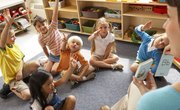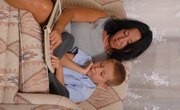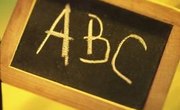First-grade reading curriculum introduces children to printed materials and to the sounds and syllables that make up words. And over the course of the school year, first-graders will start to understand how the ideas in books apply to the world around them. As of 2013, most U.S. states have adopted a set of educational standards know as the Common Core State Standard Initiative. These standards spell out first-grade reading goals that will set children on a course to become critical readers.
Components of Print
First-grade reading teaches children how printed matter works. A first-grader will learn to distinguish the parts of a book from cover to index and to read a book from front to back and from the top of the page down. She’ll also master some basics of writing sentences, such as capitalizing the first word and placing a punctuation mark at the end of a sentence.
Phonemic and Phonologic Awareness
Reading at the first-grade level encourages phonemic awareness, or the understanding of the sounds and syllables that make up words. A child will also develop phonological awareness, or the knowledge of how syllables sound when put together into words. Using these skills together, a first-grader can sound out words using individual syllables and break words down into their component syllables. He will apply this knowledge to identifying new words.
Textual Structure
A first-grader should learn the difference between different book types, such as a storybook versus a reference book. She will also learn to tell different modes of writing apart, such as prose versus poetry or a play.
Important Ideas and Details
A first-grader will begin to answer basic questions about what he reads and produce summaries. He'll be expected to retell stories, describe characters in the text and identify words that convey feelings. He should also begin to predict what might come next for literary characters given their personalities and circumstances. A first-grader will also learn to identify the key points in informative reference text and be able to differentiate between fact and opinion.
Integration of Ideas
A first-grader will start to incorporate the ideas she reads into an analysis beyond the book. She can connect book illustrations with the corresponding narrative and use images to describe the book's settings and events. She can identify and discuss the main ideas presented in books. As a first-grader masters essential speaking and listening strategies, she will begin to communicate effectively with peers and adults through guided discussion of book concepts.
Related Articles
References
- Pennsylvania Early Childhood Education Standards: First Grade
- Common Core State Standards Initiative: English Language Arts Standards: Reading: Informational Text: Grade 1
- Common Core State Standards Initiative: English Language Arts Standards: Reading: Foundational Skills: Grade 1
- Common Core State Standards Initiative: English Language Arts Standards: Reading: Literature: Grade 1
Writer Bio
Teresa J. Siskin has been a researcher, writer and editor since 2009. She holds a doctorate in art history.











